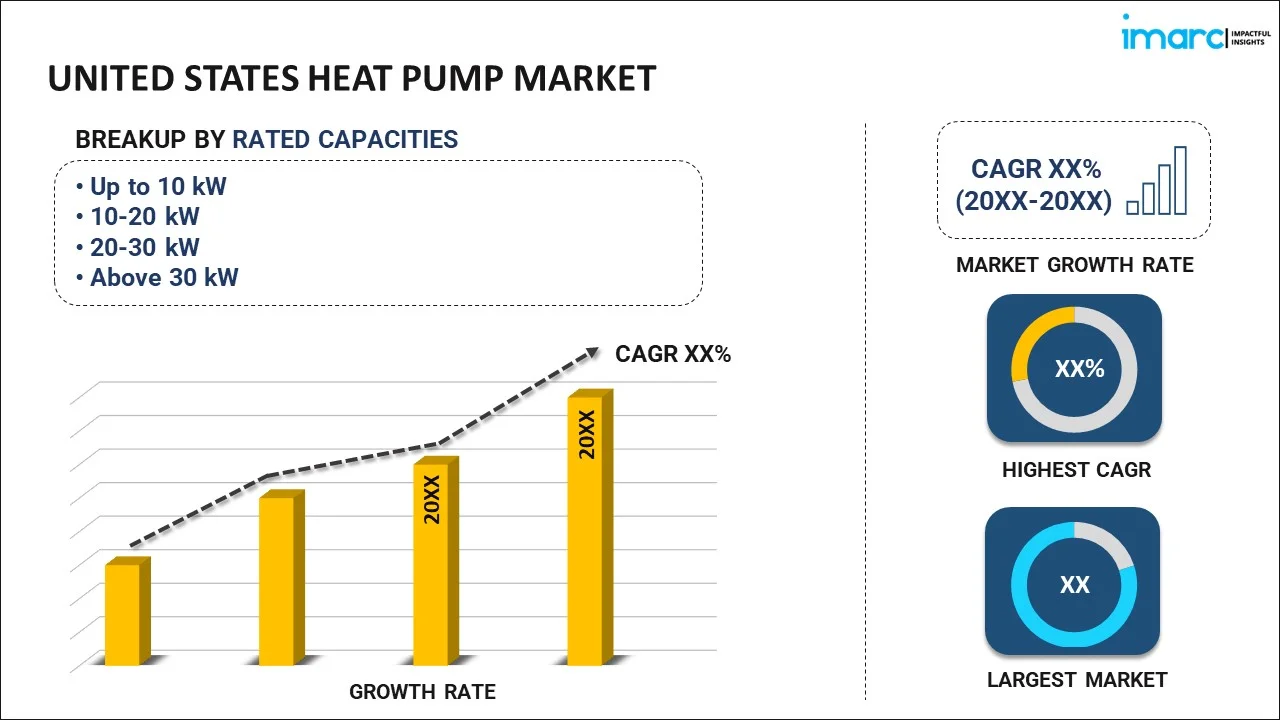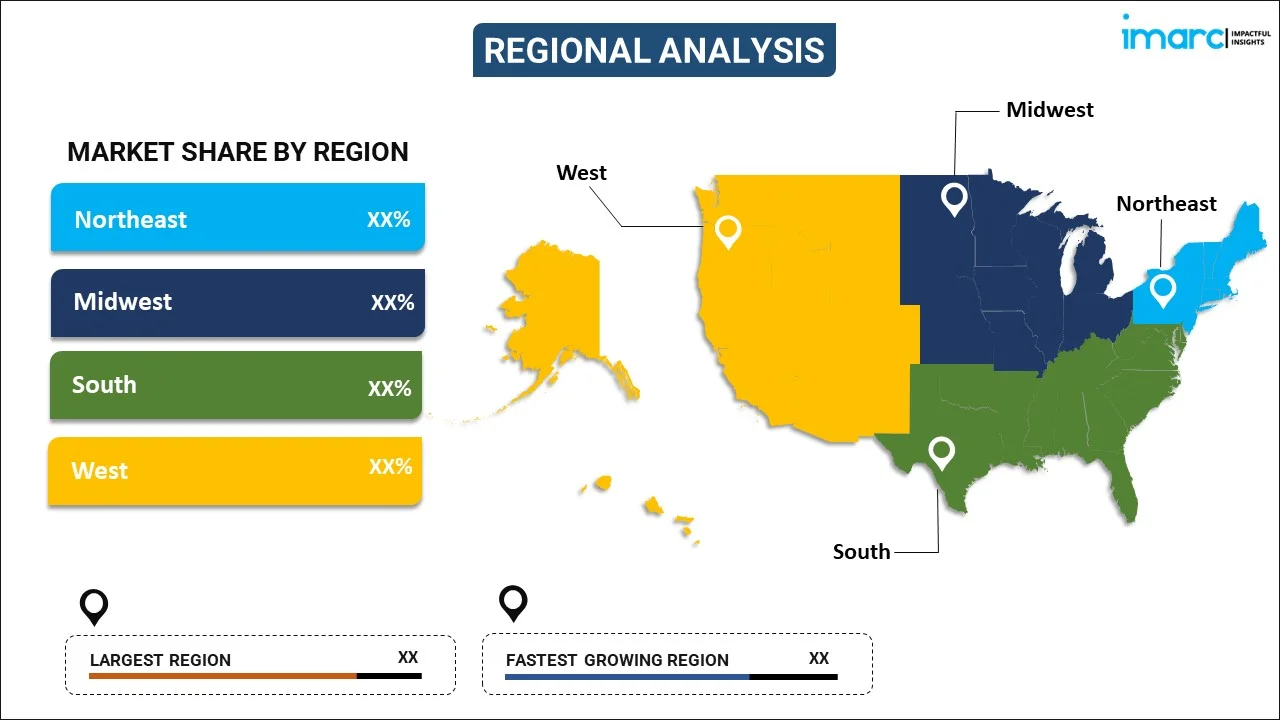
United States Heat Pump Market Report by Rated Capacity (Up to 10 kW, 10-20 kW, 20-30 kW, Above 30 kW), Product Type (Air Source Heat Pump, Ground Source Heat Pump, Water Source Heat Pump, Exhaust Air Heat Pump, and Others), End Use Sector (Residential, Commercial, Hospitality, Retail, Education, Food and Beverage, Paper and Pulp, Chemicals and Petrochemicals, and Others), and Region 2025-2033
Market Overview:
United States heat pump market size reached USD 14.6 Billion in 2024. Looking forward, IMARC Group expects the market to reach USD 33.1 Billion by 2033, exhibiting a growth rate (CAGR) of 9.5% during 2025-2033. The growing adoption of environmentally conscious solutions by individuals in the pursuit of a greener and more sustainable future is primarily driving the market growth.
|
Report Attribute
|
Key Statistics
|
|---|---|
|
Base Year
|
2024 |
|
Forecast Years
|
2025-2033
|
|
Historical Years
|
2019-2024
|
| Market Size in 2024 | USD 14.6 Billion |
| Market Forecast in 2033 | USD 33.1 Billion |
| Market Growth Rate (2025-2033) | 9.5% |
Heat pumps are energy-efficient systems designed to move heat from one location to another. These systems incorporate components like condensers, compressors, evaporators, and expansion valves to ensure effective operation. The functioning of heat pumps involves extracting heat from a source at a lower temperature, such as air, ground, or water, and transferring it to a destination with a higher temperature, typically a home or building. Widely applied for both heating and cooling purposes in residential and commercial structures, heat pumps are recognized for their environmentally friendly characteristics and cost-effectiveness. Unlike traditional methods that involve combustion for heat generation, heat pumps capitalize on existing heat sources, contributing to their reputation as efficient and eco-friendly systems.Top of Form
United States Heat Pump Market Trends:
The United States heat pump market stands as a significant player in the nation's drive toward energy efficiency and sustainable heating and cooling solutions. Heat pumps, renowned for their capacity to transfer heat between sources, find widespread application in residential and commercial buildings across the country. Additionally, comprising essential components, such as condensers, compressors, evaporators, and expansion valves, these systems efficiently extract heat from lower-temperature sources like air, ground, or water and transfer it to areas requiring higher temperatures, thereby serving both heating and cooling needs. Besides this, the U.S. heat pump market is characterized by a growing emphasis on eco-friendly practices and cost-effective solutions, given that heat pumps leverage existing heat sources instead of relying on combustion for heat generation. As the demand for energy-efficient technologies continues to rise, heat pumps play a crucial role in meeting heating and cooling requirements while reducing environmental impact. Their widespread adoption across various sectors reflects not only their effectiveness in maintaining comfortable indoor climates but also their contribution to the broader goals of sustainability and reduced carbon footprint in the United States. This, in turn, is expected to fuel the market growth in the coming years.Top of Form
United States Heat Pump Market Segmentation:
IMARC Group provides an analysis of the key trends in each segment of the market, along with forecasts at the country level for 2025-2033. Our report has categorized the market based on rated capacity, product type, and end use sector.
Rated Capacity Insights:

- Up to 10 kW
- 10-20 kW
- 20-30 kW
- Above 30 kW
The report has provided a detailed breakup and analysis of the market based on the rated capacity. This includes up to 10 kw, 10-20 kw, 20-30 kw, and above 30 kw.
Product Type Insights:
- Air Source Heat Pump
- Ground Source Heat Pump
- Water Source Heat Pump
- Exhaust Air Heat Pump
- Others
A detailed breakup and analysis of the market based on the product type have also been provided in the report. This includes air source heat pump, ground source heat pump, water source heat pump, exhaust air heat pump, and others.
End Use Sector Insights:
- Residential
- Commercial
- Hospitality
- Retail
- Education
- Food and Beverage
- Paper and Pulp
- Chemicals and Petrochemicals
- Others
The report has provided a detailed breakup and analysis of the market based on the end use sector. This includes residential, commercial, hospitality, retail, education, food and beverage, paper and pulp, chemicals and petrochemicals, and others.
Regional Insights:

- Northeast
- Midwest
- South
- West
The report has also provided a comprehensive analysis of all the major regional markets, which include Northeast, Midwest, South, and West.
Competitive Landscape:
The market research report has also provided a comprehensive analysis of the competitive landscape in the market. Competitive analysis such as market structure, key player positioning, top winning strategies, competitive dashboard, and company evaluation quadrant has been covered in the report. Also, detailed profiles of all major companies have been provided.
United States Heat Pump Market Report Coverage:
| Report Features | Details |
|---|---|
| Base Year of the Analysis | 2024 |
| Historical Period | 2019-2024 |
| Forecast Period | 2025-2033 |
| Units | Billion USD |
| Scope of the Report | Exploration of Historical Trends and Market Outlook, Industry Catalysts and Challenges, Segment-Wise Historical and Future Market Assessment:
|
| Rated Capacities Covered | Up to 10 kW, 10-20 kW, 20-30 kW, Above 30 kW |
| Product Types Covered | Air Source Heat Pump, Ground Source Heat Pump, Water Source Heat Pump, Exhaust Air Heat Pump, Others |
| End Use Sectors Covered | Residential, Commercial, Hospitality, Retail, Education, Food and Beverage, Paper and Pulp, Chemicals and Petrochemicals, Others |
| Regions Covered | Northeast, Midwest, South, West |
| Customization Scope | 10% Free Customization |
| Post-Sale Analyst Support | 10-12 Weeks |
| Delivery Format | PDF and Excel through Email (We can also provide the editable version of the report in PPT/Word format on special request) |
Key Questions Answered in This Report:
- How has the United States heat pump market performed so far and how will it perform in the coming years?
- What has been the impact of COVID-19 on the United States heat pump market?
- What is the breakup of the United States heat pump market on the basis of rated capacity?
- What is the breakup of the United States heat pump market on the basis of product type?
- What is the breakup of the United States heat pump market on the basis of end use sector?
- What are the various stages in the value chain of the United States heat pump market?
- What are the key driving factors and challenges in the United States heat pump?
- What is the structure of the United States heat pump market and who are the key players?
- What is the degree of competition in the United States heat pump market?
Key Benefits for Stakeholders:
- IMARC’s industry report offers a comprehensive quantitative analysis of various market segments, historical and current market trends, market forecasts, and dynamics of the United States heat pump market from 2019-2033.
- The research report provides the latest information on the market drivers, challenges, and opportunities in the United States heat pump market.
- Porter's five forces analysis assist stakeholders in assessing the impact of new entrants, competitive rivalry, supplier power, buyer power, and the threat of substitution. It helps stakeholders to analyze the level of competition within the United States heat pump industry and its attractiveness.
- Competitive landscape allows stakeholders to understand their competitive environment and provides an insight into the current positions of key players in the market.
Need more help?
- Speak to our experienced analysts for insights on the current market scenarios.
- Include additional segments and countries to customize the report as per your requirement.
- Gain an unparalleled competitive advantage in your domain by understanding how to utilize the report and positively impacting your operations and revenue.
- For further assistance, please connect with our analysts.
 Inquire Before Buying
Inquire Before Buying
 Speak to an Analyst
Speak to an Analyst
 Request Brochure
Request Brochure
 Request Customization
Request Customization




.webp)




.webp)












